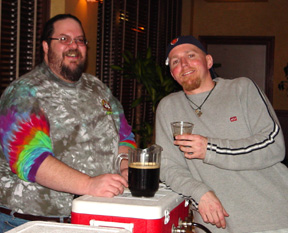|
ALES
FROM THE WOODS
In the
old days, brewers served beer aged in oaken casks. Now, brewers are
rolling back the barrels for flavoring beer.
A new
festival
of barrel-aged beer shone light on this ancient brewing technique,
as adapted by American craft brewers. Organized by Todd Ashman, (former) brewmaster
at the Flossmoor Station in suburban Chicago and Pete Crowley of Chicago's
Rock Bottom Brewery, the Festival of Barrel-Aged Beer drew almost
50 entries from Alaska to Delaware, showcasing ambitious examples
of American wood-aged brews. 
In a
show of support, Miller Brewing Co.'s pilot brewery in Milwaukee sent
along a barrel of its Fred Miller 1880 barleywine - an experimental
brew.
The tradition
of aging beer in wood began in Belgium. In Flanders, barrel-aged "red
ales" are still sought after. One of the pricier brands sold in the
U.S. is made by Rodenbach. Garrett Oliver, author of "The Brewmaster's
Table" (Ecco/Harper Collins, May 2003), says of Rodenbach, "The most
important tradition is that of aging the red ale in huge vats of unlined
oak. The wood is home to dozens of wild yeasts," which spur the fermentation
of residual sugars.
Thus,
over the months and years, the ale grows in acidity, aroma and depth
of flavor. American brewmasters, such as Wisconsin's Dan Carey of
the New Glarus Brewing Co., took that tradition and rolled out a slightly
different barrel.
The award-winning
New Glarus Belgian Red is a good example of wood-aged fruit beer,
similar to a kriek, a Belgian ale made with cherries.
"We started
to ferment the Belgian Red in 3,000-gallon oak vats about seven years
ago," says Carey. "We purchased these oak vats from the Rodney Strong
Winery in Russian River, California." "These oak vats are not only
the home to a large microflora of bacteria helpful for our spontaneous
fermentation, but also lend a background of red wine character to
the beer," Carey adds. Fruit beers are natural complements to the
"sour" character of old red wine.
"Most
people fail to realize that good fruit beer needs a 'backbone' of
sourness," Carey says.
There
is another type of barrel, the bourbon barrel, used in the aging of
beer. Some southeastern Wisconsin breweries that age some of their
beers in whiskey barrels, especially old bourbon barrels, include
the Milwaukee Ale House, Delafield Brewhaus, and Tyranena Brewing
Co.
Big beers,
such as stouts, bocks and barleywines, are best suited to barrel aging.
"A beer needs sufficient malt character to stand up to the powerful
flavors of oak," Ashman says. "Last year, I experimented by aging
a barleywine in an untreated, virgin oak barrel, and the raw wood
flavor just consumed the barleywine. I learned that wood barrels used
before to age other spirits or wine work best in aging beer," Ashman
notes.
Barrels
used to age bourbon or whiskey are typically charred black on the
interior surfaces. The charcoal notes help mellow the spirits and
charring maintains a relatively microbe-free start to the maturation.
Such dark wood marries well with the dark roasted malts used to make
stouts and barleywines.
Carey
says that traditional wooden beer kegs (which they take to festivals)
are lined with pitch. "One of our brewers used to have this job at
the Dubuque Star Brewery - it's a very nasty job," he said. The pitch
prevents any flavor of the wood infusing the ale. To maintain their
gigantic vats, the New Glarus Brewing Co. steams the empty vessels
to keep them moist. "Otherwise, the wood will shrink and leak," says
Carey. This is followed by burning sulfur wicks in them to prevent
the growth of mold ("keep the wood sweet"). With labor and time, the
taste of barrel-aged beer develops into something as complex and varied
as a fine wine. "Oak aging allows us to develop a winelike acidity
in our fruit beers," says Carey.
To learn more about the current festival, now known as the Festival of Wood and Barrel Aged Beers, visit the Illinois Craft Brewers website, http://www.illinoisbeer.com
A longer
version of this article appeared in the CELEBRATOR BEER NEWS.
|